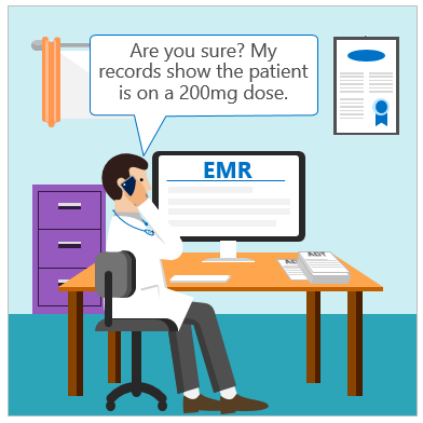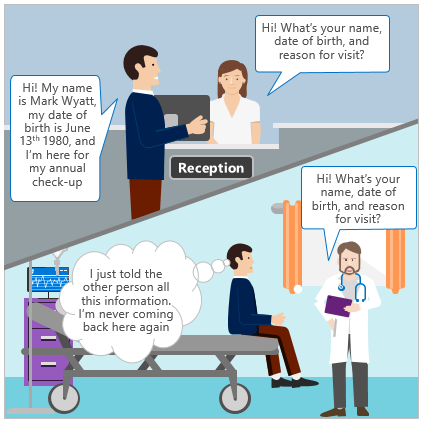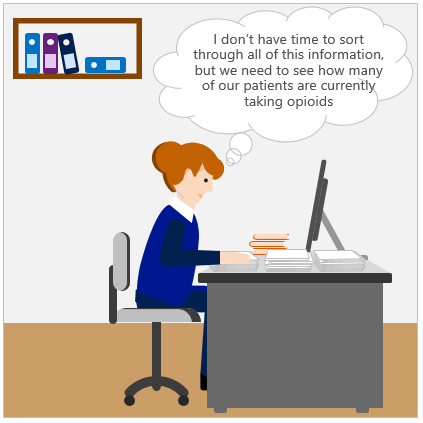
How to treat 3 common pains in your care team
Medical treatments are making astonishing advances, but there is often a lag between those advances and best practices on how to integrate those treatments into the medical community. A clear example of this is the opioid consumption over the past 20 years. In the 1990s, the key directive for healthcare providers was to minimize paini. With this directive, doctors prescribed opioid at higher rates than they might have otherwise. For patients that truly benefited from these life changing drugs, this was an amazing change. However, what seemed like a newfound source of freedom became an epidemic, partially due to a lack of communication between doctors, specialists, and pharmacists. Today, opioid addiction has reached epidemic levelsii. To combat this epidemic, hospitals now need to account for every single opioid pill, and closely monitor the prescription of those pills.
Yet, errors still arise from a lack of essential communication. In fact, 70% of medical errors and adverse events in healthcare are a result of communication failures between providers who are treating the same patient in isolation from one anotheriii. For example, patients who are determined to manipulate the system can see multiple care providers, and “doctor shop”, until they receive the prescription they want. Unfortunately, there are several challenges that make it difficult for care teams to improve communication and gain visibility into patient records. Let’s examine some of the challenges that healthcare teams face through the eyes of three key team members in different roles.
Disconnected data prevents efficient care team communication
 Ted, a Chief Nursing Officer, recognizes that his teammates don’t have the time they need to view and understand patient information that is stored in multiple systems. This is a huge issue considering that physicians in private practice caring for Medicare patients interact with as many as 229 other physicians at 117 different practices each yeariv. When a patient requests pain medication, it is difficult for care teams to access the entire patient history to determine the best course of action. Having information stored in multiple systems is a huge drain on resources. From charting, re-charting, diagnosing, investigating symptoms, and documenting information, a huge amount of time is wasted. This effort results in wasted time and higher probabilities for errors, especially with care teams using different electronic medical record (EMR) systems in each practice. Siloed data doesn’t just make the care teams job harder, it makes patient satisfaction harder to achieve. Unshared information results in more acute episodes requiring hospitalization and ER visits. The reality is visibility and understanding are key, and errors can have devastating consequences.
Ted, a Chief Nursing Officer, recognizes that his teammates don’t have the time they need to view and understand patient information that is stored in multiple systems. This is a huge issue considering that physicians in private practice caring for Medicare patients interact with as many as 229 other physicians at 117 different practices each yeariv. When a patient requests pain medication, it is difficult for care teams to access the entire patient history to determine the best course of action. Having information stored in multiple systems is a huge drain on resources. From charting, re-charting, diagnosing, investigating symptoms, and documenting information, a huge amount of time is wasted. This effort results in wasted time and higher probabilities for errors, especially with care teams using different electronic medical record (EMR) systems in each practice. Siloed data doesn’t just make the care teams job harder, it makes patient satisfaction harder to achieve. Unshared information results in more acute episodes requiring hospitalization and ER visits. The reality is visibility and understanding are key, and errors can have devastating consequences.
Reduced patient satisfaction due to a lack of personalization
 Matthew, the Director of Patient Care, sees that the care team is struggling to provide personalized patient encounters with high volumes of patients, as they don’t have access to the right information, at the right time. As he reviews patient surveys, he notices that patients complain about having to explain their symptoms to various team members repeatedly. If the hospital wants to successfully deliver improved health outcomes, better patient care and lower costs, they need to figure out a way to change this reality. This is especially important since patients are less likely to adhere to treatment plans, maintain a relationship with their care provider, or return to the same provider if they are if they are dissatisfied. Each of these can result in a costly, and potentially harmful, lapse in care coverage.
Matthew, the Director of Patient Care, sees that the care team is struggling to provide personalized patient encounters with high volumes of patients, as they don’t have access to the right information, at the right time. As he reviews patient surveys, he notices that patients complain about having to explain their symptoms to various team members repeatedly. If the hospital wants to successfully deliver improved health outcomes, better patient care and lower costs, they need to figure out a way to change this reality. This is especially important since patients are less likely to adhere to treatment plans, maintain a relationship with their care provider, or return to the same provider if they are if they are dissatisfied. Each of these can result in a costly, and potentially harmful, lapse in care coverage.
Inaccessible insights from the data on hand
 Mary, the Chief Operations officer, sees that care providers are faithfully using the EMR systems, but that most EMRs do not have any way to pull meaningful insights from that data. This is mainly because the data in the EMR is static, cumbersome, and unwieldy. This makes it very difficult for her to zoom in and understand any given topic, like the number of patients currently on narcotics, who prescribed them, and how often they pick up those prescriptions. With this type of information, they could target abusers. Ideally, Mary would have a system that would provide this information while also providing analytics to target and improve areas of the hospital that run inefficiently. As it stands right now, EMRs are time consuming, nearly impossible to distill insights from. Additionally, data housed in most EMRs is incredibly cumbersome and unwieldy. If she wanted to access information on the number of patients where are taking opioids, it would be time consuming, and nearly impossible. On top of this, when Mary needs to improve her operations down the line she will have to implement, and overhaul her entire system. She won’t have a way to improve patient care by seamlessly adding on new capabilities over time.
Mary, the Chief Operations officer, sees that care providers are faithfully using the EMR systems, but that most EMRs do not have any way to pull meaningful insights from that data. This is mainly because the data in the EMR is static, cumbersome, and unwieldy. This makes it very difficult for her to zoom in and understand any given topic, like the number of patients currently on narcotics, who prescribed them, and how often they pick up those prescriptions. With this type of information, they could target abusers. Ideally, Mary would have a system that would provide this information while also providing analytics to target and improve areas of the hospital that run inefficiently. As it stands right now, EMRs are time consuming, nearly impossible to distill insights from. Additionally, data housed in most EMRs is incredibly cumbersome and unwieldy. If she wanted to access information on the number of patients where are taking opioids, it would be time consuming, and nearly impossible. On top of this, when Mary needs to improve her operations down the line she will have to implement, and overhaul her entire system. She won’t have a way to improve patient care by seamlessly adding on new capabilities over time.
Tribridge’s Health360 Engagement Center alleviates these pains
Advanced healthcare technology has the potential to support better communication across primary care and specialty substance use disorder treatment centers, increase safety by reducing harmful drug-drug interactions, and improve monitoring of treatment outcomes and relapse risk in general health carev. Communication tools and interoperability between general healthcare providers, specialty substance treatment centers, and other social institutions empowers better decision-making and more effective treatment.
Tribridge Health360 Engagement Center, built on Microsoft cloud technology, helps healthcare organization overcome these pains. It leverages data from EMRs and many other systems to present a consumer-first, 360-degree view of patients. All of this, while providing the foundation to allow care teams to personalize interactions and create better overall care experiences.
One example is the partnership with AiR (Assistance in Recovery) a provider of disease management and telephone-based care coordination solutions for chronic behavioral health conditions. With Tribridge and Microsoft AiR could expand their reach and abilities. “Before, we were limited in the types of reporting and information that we could query within a system. It was never clear if what we were doing was meaningful.” Now they are empowered to leverage their data. They can harness the power of the data in the system and use it to get better and grow.
Care teams can aggregate data from many different sources into a single patient file, creating a “golden record” that provides a single source of truth for both patients and providers. In addition, they can drive increased patient satisfaction by delivering a personalized experience from the first point of contact. There is also the ability to handle high volumes of patient records across care locations and organizations. Learn more about the Tribridge Health360 Engagement Center solution and try the preview on Microsoft AppSource.
_____________________________________________________________________________________________________
ihttps://www.ncbi.nlm.nih.gov/pmc/articles/PMC1071521/#ref1
iihttps://www.cdc.gov/drugoverdose/epidemic/
iiihttps://www.ncbi.nlm.nih.gov/pmc/articles/PMC3243259/
ivhttps://medicalreview.columbia.edu/article/communication-healthcare/


![[4:56 PM] Jordan Davis (Wipro Designit Services, Inc.) Green background with colored swoops on the top and an image of a young adult helping older adult with a computer.](https://www.microsoft.com/en-us/industry/blog/wp-content/uploads/2024/04/MSFT_Azure_APR08_328468_Blog_Blogheader_240408_V01-1-300x169.webp)

